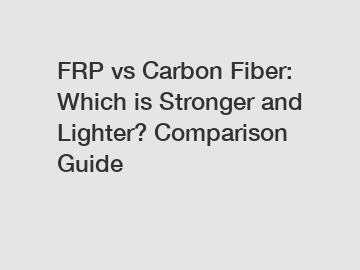In the world of advanced materials and composites, two terms that often come up in discussions are FRP (Fiber Reinforced Plastic) and Carbon Fiber. Both materials are renowned for their strength and lightweight properties, making them popular choices for a wide range of applications in various industries. But when it comes down to it, which material is truly stronger and lighter? In this comparison guide, we'll take a closer look at the key differences between FRP and Carbon Fiber to help you make an informed decision for your next project.
FRP is a composite material made up of a polymer matrix reinforced with fibers such as fiberglass, carbon, or aramid. It is known for its excellent corrosion resistance, high strength-to-weight ratio, and affordability. FRP is commonly used in applications where durability and cost-effectiveness are key considerations, such as in the construction of boats, automotive parts, and industrial tanks.
On the other hand, Carbon Fiber is a composite material composed of carbon fibers embedded in a polymer matrix. Carbon Fiber is known for its exceptional strength, stiffness, and lightweight properties, making it a popular choice for high-performance applications where weight savings are critical, such as in aerospace, automotive racing, and sporting goods.

In terms of strength, Carbon Fiber is generally considered to be stronger than FRP due to the inherent properties of carbon fibers. Carbon fibers have a higher tensile strength and stiffness compared to fiberglass or other fibers commonly used in FRP composites, making Carbon Fiber composites more capable of withstanding high loads and stresses without deforming or failing.
Additionally, Carbon Fiber has a higher fatigue resistance compared to FRP, meaning it can withstand repeated loading and unloading cycles without experiencing a loss of strength or performance. This is a crucial factor in applications where durability and long-term reliability are essential, such as in the construction of aircraft components or high-performance racing cars.
When it comes to weight, Carbon Fiber is also lighter than FRP due to its low density and high specific strength. Carbon Fiber composites can achieve significant weight savings compared to traditional materials like steel or aluminum, making them ideal for applications where weight reduction is a priority, such as in the production of lightweight sports equipment or structural components for spacecraft.
However, it's important to note that the strength and weight of a composite material are not the only factors to consider when choosing between FRP and Carbon Fiber. Other factors such as cost, manufacturing process, and environmental considerations also play a significant role in determining the suitability of a material for a particular application.
FRP is generally more cost-effective than Carbon Fiber, making it a preferred choice for applications where budget constraints are a concern. The manufacturing process for FRP is also relatively simple and can be easily scaled up for mass production, making it a versatile option for a wide range of industries.
On the other hand, Carbon Fiber composites are more expensive to produce due to the high cost of carbon fibers and the complex manufacturing process involved. However, the exceptional performance and weight savings offered by Carbon Fiber make it a worthwhile investment for applications where superior strength and lightweight properties are required.
In terms of environmental considerations, both FRP and Carbon Fiber have their own advantages and drawbacks. FRP is recyclable and can be repurposed or reused at the end of its life cycle, making it a sustainable choice for environmentally conscious projects. On the other hand, Carbon Fiber is not easily recyclable and can pose challenges for disposal and waste management.
Ultimately, the choice between FRP and Carbon Fiber will depend on the specific requirements of your project, including strength, weight, cost, and environmental considerations. If you're looking for a cost-effective and versatile material with good overall performance, FRP may be the best option for you. However, if you require exceptional strength, stiffness, and weight savings for a high-performance application, Carbon Fiber may be the ideal choice for your project.
In conclusion, both FRP and Carbon Fiber have their own unique advantages and strengths, making them popular choices for a wide range of applications in various industries. While Carbon Fiber is generally considered to be stronger and lighter than FRP, the choice between the two materials will ultimately depend on your specific project requirements and priorities. Whichever material you choose, both FRP and Carbon Fiber offer excellent performance and durability for a wide range of applications.
If you are looking for more details, kindly visit septic tank material, FRP Fiber Flange, refined wuartz.





Comments
0